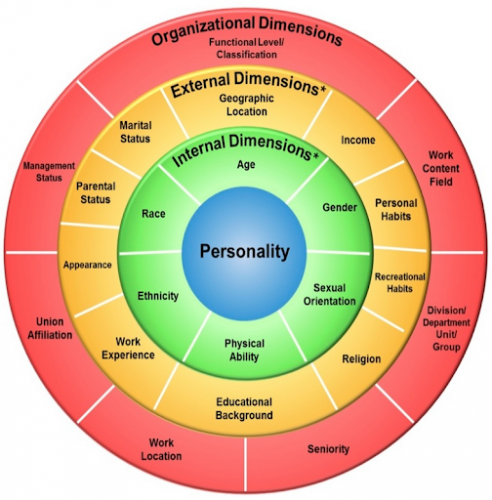In our first post we described the origins of this UX and assessment project, and what led to the research described below. This second blog post describes our research process.
Experience Mapping
In order to create a way for our library colleagues to examine gaps in knowledge about our university community, we spent time learning more about the experience of different populations attending U-M. The Library Lifecycle team recognized that the use of library services is only one part of the academic and professional journeys our community pursues. To more fully understand our diverse community on campus, the team began with Experience Mapping,a series of methods where user researchers learn about an environment they want to describe through research, data analysis, and then development of a story about the experiences in the chosen environment. From there, service designers can use the results to consider opportunities for innovation.
Our first step was to understand what influenced our library ecosystem. We wanted to describe the broad experiences of faculty, students and staff on U-M’s campus. Using personas previously created by an external consultant -- “Undergrad Dan,” “Graduate Anne,” and “Faculty Frank” -- we mapped all of the influencers that came to mind on a bullseye, with most direct influencers in the middle and more indirect influencers in the outlying concentric circles.

Figure 1: Chris Risdon, “Mapping Experiences: revealing the hub of empathy, understanding and strategy, Conference workshop at Midwest UX, October 2017. Page 40.
We then took all of the sticky notes and mapped common influencers that seemed to apply across personas. These associations guided emerging themes categorized into five “influencer contexts.”
We named these contexts the Personal, Social, Logistical, Professional and External:
-
Personal: More internal influencers related to personal well being that impact campus life for users. Things like mental and physical health, home life, feelings, stress, happiness etc.
-
Social: How a person is influenced by their social context. Their aspirations, being social for wellbeing, social isolation or anxiety, friends, fun, social pressure, family expectations, romantic life etc.
-
Logistical: influencers based on what the person is doing day-to-day, technology they are using, resources available, commuting, daily needs/tasks to accomplish what they want to do.
-
Professional: influencers from the person's professional domain, activity done to further professional/academic goals, requirements of the job market, expectations from professional organizations, requirements from a boss, professional aspirations, pursuing networking opportunities etc.
-
External: External factors mostly outside of the user's control that influence their life on campus. Things like politics, university policy, program/job requirements, weather etc.
These big bucket, high level categories were used to categorize data that was compiled and collected for the project. Our team worked within this constructed framework to better grasp the different aspects of experience that we sought to document for library colleagues.
Conducting Interviews
We next compiled user research previously collected about library users at our institution as well as more broadly within the realm of higher education. Findings were coded from these reports using the influencer framework definitions to draw out subcategories and to document themes about experience. We learned that there is a lot of published research related to our influencer framework definition of the Professional contexts of people in academic environments and not as much about the Personal, Social, Logistical and External influencers impacting behavior and decision-making. Our team decided to conduct our own research in this sphere.
In March and April of 2018, we conducted 30 contextual interviews about campus experience with:
-
14 current undergraduates,
-
3 recent undergraduate alumni,
-
5 PhD candidates,
-
3 graduate students,
-
3 staff and
-
2 lecturers
Participants’ disciplines ranged from medical studies, natural sciences, business, humanities, social sciences, and architecture. In a contextual-inquiry style approach, we went to participants holding interviews in faculty offices, cafes near campus in addition to library meeting rooms.
Because we sought to holistically understand how different parts of identity might be influencing decision making, our interview questions were open-ended. We wanted to know what our users’ social experiences were like on campus, and how their personal identity and the world/campus setting influence their behavior. We also wanted to know about our users’ professional aspirations and goals, and how available resources and the world/campus setting influence the choices they made. To prompt interviewees to talk about the parts of their identity that felt most relevant or poignant, we used an identity wheel that listed different parts of life that made up their backgrounds and social identities. The wheel allowed interviewees to reflect on our questions and open up about what they had experienced on campus.

Figure 2. Adapted from Gardenswartz, L., & Rowe, A. (2008). Diverse teams at work: Capitalizing on the power of diversity. Alexandria, Va: Society for Human Resource Management.
This interview data was combined with the experience mapping data we previously compiled. And although there were many more stories we weren't able to reveal and document, the threads of participants' experiences on campus greatly expanded our team's understanding about who our users are and what they were coping with while at U-M.
This research inspired us to create an interactive resource that would be thought-provoking for our colleagues, helping develop ideas about what else they might learn about our library users. We will describe this work in our third post.
(Submitted by Denise Leyton, Jordan Gorzalski, Sophia McFadden-Keesling, and Caroline Wack.)